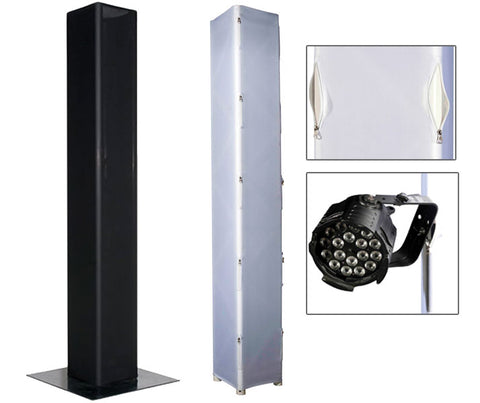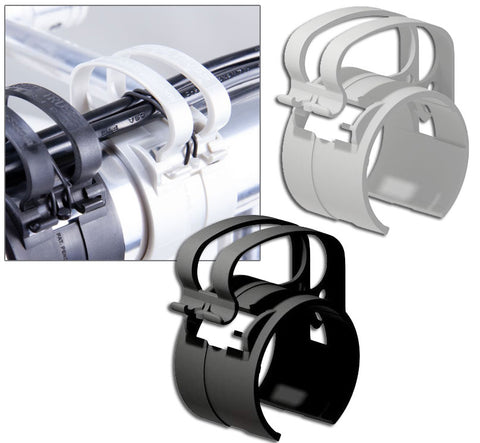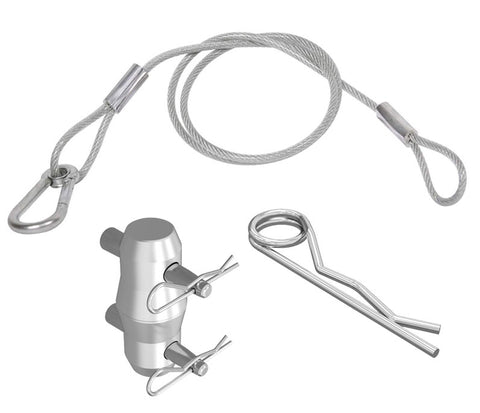In this article we will attempt to shine a spotlight on the hardware that has been standing tall and making its way to the front of most production/event environments. Maintenance can be approached in 2 ways: Appearance and Safety.
Appearance: What do you use it for and how is appearance relevant to your application? Whether you are a mobile DJ doing gigs in a back yard or providing a touch of elegance at a wedding, your signature is reflected through your presentation. Similarly, your stage design at a performance venue or house of worship is greatly impacted by truss. Your presentation can either appear to be a rough/industrial bent metal workhorse or an elegant form that plays an intricate part in the installation. First let's take a look at a few simple, but popular set ups that are being used by DJ’s, event producers, and houses of worship.
Truss totems are multi-purpose structures that have stood out in the working disc jockey and entertainment community for use in weddings, parties and all types of events. This truss checks the boxes of both form and function. It not only shows well but is also a versatile element that looks elegant at times or “industrially” cool, it just depends on the application and environment.
Let’s explore the variety of ways to add a bit of a signature look in appearance. Simple black coverings like the Global Truss GT-TC2.0-BLK 6.56 Ft 2M Black Truss Cover hide the aluminum heavy look, while keeping its form. Black hardware and gear typically minimize their appearance, but here they do the opposite and it’s just the right statement.

These cosmetic additions will certainly add a great deal of value to your investment and stretch the offerings to your clients and environments. Now let's consider some standard basic practices that are just considered versatile. Cable management like the Global Truss DT-SNAP/LT Cable Management (also available in black) has been labeled as one of the top practices among professionals as loosely dropped audio/mic cables, DMX cables coiled in loops, and webbed AC extension cords have negatively reflected on a set up's image up until now. With these cable management clamps from Global Truss you can match your cable color with the black version or your truss color with the gray version. Not to mention, gaffer’s tape can be used a lot less, which is a plus.

Safety: What do you use it for and how is safety-critical to your application? What are some of the potentially “unforeseen” safety practices that can really be critical to an accident-free event? Understanding the capabilities of truss is critical for clear sailing at your events.
Inspection is the number one key to proper usage of your truss inventory. What are you looking for exactly? Primarily three things:
- Any dents or divots long the chords (main large tube portion, typically 2” in diameter). Generally speaking, these dents, if found, can highly affect the integrity of the truss capabilities and strength.
- Any cracks, dents or divots along the bracing of the truss. These smaller tubes zig-zagging up and down inside the truss are highly important to the overall rigidity.
- Pins, Clips, and Couplers: these are the hardware pieces needed to keep everything locked in and tightened down.
These are the things to pay attention to:
- Pins: have they been “hammered” down and as a result, been disfigured.
- Clips: should always be used. If a clip is not harnessed completely, it will leave room for the pin to slip out, thus loosening the truss and risking a disconnection.
-
Couplers: these are the male to male “nuggets” that sit inside and in between the truss connection. This part should be looked at for any damage or deformations.
*Note: Each and every piece of hardware MUST be used to meet specifications of weight loads etc.

Stabilize Your Truss!
Now that we have a grasp on the safety of the actual pieces of truss, what about the items that help support the truss? In general, if you have a 2-dimensional truss structure, you’ll need something to make sure that the truss does not come crashing down. Be sure to have the properly rated stands and don’t hesitate to use outriggers (legs that give the stand an even wider footprint). Lastly, sandbags are something to have on hand to provide extra weight and therefore stability to the base of your truss structure.
No stands? Be safe and fly/hang your truss the right way. Some of the products you’ll need to fly/hang truss are wire rope and shackles.
Going Beyond the Basic User, Maintenance Practice
Please see the following example to help understand truss strengths, capacities and weight loads. Look at the highlighted areas in yellow and the red circled area. Breakdown: a 19.68’ (approx. 20’) span of F34 Truss (12” Square), used in the horizontal position in this case: Total Load (highlighted in yellow): Shows capacity, with a general spread of gear along the 20’ span. Deflection (highlighted in yellow): Refers to possible bending of the span of truss.
*Note: These are general pieces of information that should assist you with your set ups.

As you can see there is an insert for “Center Load” which is not highlighted here. Generally, this means if all your gear is mounted at the center of the span, you will see a significant reduction in the total available load by not spreading out the weight. The main thing you want to keep in mind is HOW are you using the truss? Horizontally? Vertically? More decoratively? How many pieces are you using to achieve a specific span? Is the connection point at the center of the span? Use the answers to these questions to inspect your truss and build a safe assembly.
As lights, cameras, speakers, etc. have gotten smaller and lighter over the years, weight loads generally have become less of an issue.
While there is a lot to consider regarding the safety of your truss, remember that our truss specialists at PSSL are always here to help if there are still lingering questions. Please contact your representative at PSSL to get more specific instructions on your structures.



